
Spring Fire Truck Maintenance Tips

Winter is over and spring is upon us. The birds are singing, the flowers are blooming, and, of course, the weather is getting warmer. You will also notice that your fire truck is covered in the brine, grit, and dirt that comes with cold-weather driving. It’s time to get your fire trucks clean, maintained, and equipped for the warm months ahead. Before getting started, review these tips for getting your trucks springtime ready.
It’s always a good idea to begin by giving your trucks a thorough cleaning to ensure all salt and other road agents are removed from the body and the electrical components. This will help prevent corrosion.
This is also a good time to have the annual undercoating done to your unit. The undercoating also helps prevent corrosion.
If your truck is fitted with Onspot traction chains, it’s important to take several steps to get everything in proper working order. First, the chain system needs to be checked every time the vehicle is brought in for a PM. When servicing the system in this manner, the chain wheels need to spin freely with no binding and the chain plates and wheel hubs need to be checked for excessive wear. Also:
- Make sure that the arm pivot points and angle joints are greased.
- The system also needs to be engaged and disengaged to ensure all parts move freely, the solenoid is working, and the chain wheels are operating at the proper angles.
- The system should be engaged and disengaged at least once a month, if not more, to keep the system “exercised.”
Spring is also the time to remove the heat pan under the pump compartment. The heat pan is used during the winter months to keep heat within the pump compartment to combat potential freezing. During the warmer months, it is best to remove it to allow the heat to escape.
You will also want to have annual pump testing performed to ensure the pump and all the valves are working correctly. This is a full test of a pump’s capabilities and probably one of the most important evaluations you’ll conduct. The test measures flow and pressure and confirms that the fire pump is ready to respond to a service call. In addition, it can uncover any problems with the pump’s water supply, such as leaking valves or obstructions between the supply and the equipment.
It’s important to remember that the fire pump is temporarily taken offline during the testing period, so nothing beyond what’s considered “normal operations” should be taking place concurrently. During the test, make sure to take safety precautions since the pump will be operating at extreme conditions. This includes wearing protective gear and testing in properly ventilated areas. Also, use hoses that have passed a service test within the past 12 months while shutting down discharges before changing nozzles.
Standards require that the test results should not deviate by more than 5% from the initial acceptance test performed right after the fire pump was installed or the pressures indicated on its nameplate. If you don’t have this information, an acceptable test should deliver:
- 150% of rated capacity at 65% of rated pressure
- 100% of rated capacity at rated pressure
- A maximum of 140% of rated pressure at churn (no flow)
Aerial maintenance should also be addressed during this time. Make sure to degrease and lubricate the aerial and fly sections, booms, etc., as per the manufacturers’ recommendations. Brine and road dirt tend to stick to aerial and tip equipment and monitors, and this debris can also destroy wiring circuit boards, bearings, and bushings. The brine will seep into all aerial sections and can eat away at the equipment over time. You can prevent damage to the truck by washing all parts with liquid soap and water. Take extra care when cleaning the aerial if your department service area includes dirt roads. Dirt can act like sandpaper, etching into sliders, cables, sheaves, and hydraulics. Deep cleaning the aerial also gives crews an opportunity to see up close the parts of the apparatus and how they work.
Another item on your spring-cleaning to-do list should be the tire rims and the fasteners that hold them onto the truck. Be sure to inspect the rims all the way around, front and back sides. If you are dealing with rims that are steel, check for excessive rust and flaking and replace if necessary. In addition, if the fasteners or wheel nuts holding that wheel on are in bad shape, replace them as well and ensure that they are torqued back on the truck and retorqued after 100 kilometers.
Lastly, and most importantly, stay safe and enjoy the season.
